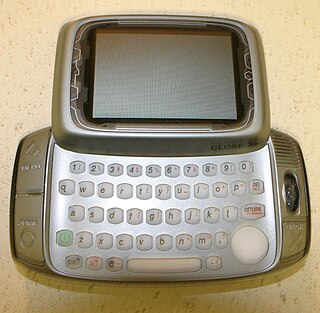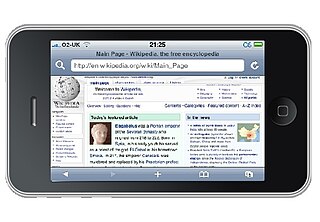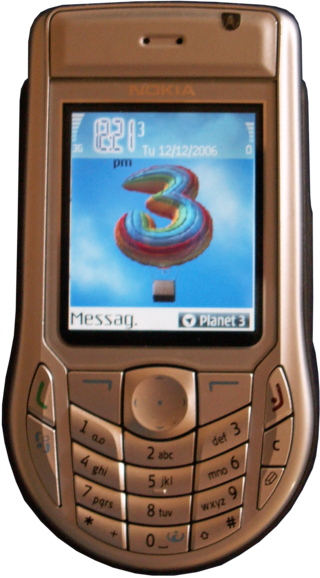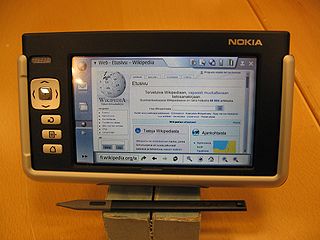
The Danger Hiptop, also re-branded as the T-Mobile Sidekick, Mobiflip and Sharp Jump, is a GPRS/EDGE/UMTS smartphone that was produced by Danger, Inc. from 2002 to 2010.

The Nokia 7610 is a Symbian OS mobile phone introduced at CEBIT on 18 March 2004. It features a 1 megapixel camera with a design similar to 2003's Nokia 7600. It went on sale with a list price of €500 and came with a 64 MB MMC card. It runs on Nokia's Series 60 platform. It was marketed as a stylish and imaging device, and allowed direct Bluetooth photo printing. End-users can also use the 7610 with Nokia Lifeblog. Other pre-installed applications include the Opera Mobile web browser, RealPlayer and Kodak Photo Sharing.

A mobile browser is a web browser designed for use on a mobile device such as a mobile phone, PDA, smartphone, or tablet. Mobile browsers are optimized to display web content most effectively on small screens on portable devices. Some mobile browsers, especially older versions, are designed to be small and efficient to accommodate the low memory capacity and low bandwidth of certain wireless handheld devices. Traditional smaller feature phones use stripped-down mobile web browsers; however, most current smartphones have full-fledged browsers that can handle the latest web technologies, such as CSS 3, JavaScript, and Ajax.

The Nokia 9210 Communicator is a third-generation Communicator series mobile phone produced by Nokia, announced on 21 November 2000 and released in June 2001. It greatly improved on the second generation Nokia 9110 Communicator, providing a colour main screen and using an ARM processor. It is one of the few mobile phones able to send and receive fax.
A Rich Internet Application is a web application that has many of the characteristics of desktop application software. The concept is closely related to a single-page application, and may allow the user interactive features such as drag and drop, background menu, WYSIWYG editing, etc. The concept was first introduced in 2002 by Macromedia to describe Macromedia Flash MX product. Throughout the 2000-s, the term was generalized to describe browser-based applications developed with other competing browser plugin technologies including Java applets, Microsoft Silverlight.

The Nokia 9000 Communicator was the first product in Nokia's Communicator series, announced at CeBIT 1996 and introduced into the market on 15 August 1996. The phone weighed 397 grams (14.0 oz), was powered by an Intel 24 MHz i386 CPU, and had 8 MB of memory. The memory was divided between applications, program memory and user data. The operating system was PEN/GEOS 3.0. The Communicator was one of the earliest smartphones on the market, after the IBM Simon in 1994 and the HP OmniGo 700LX, a DOS-based palmtop PC with integrated cradle for the Nokia 2110 cellular mobile phone, announced in late 1995 and shipped in March 1996.

Windows Mobile is a discontinued mobile operating system developed by Microsoft for smartphones and personal digital assistants.

The Nokia 6630 is a 3G mobile phone announced by Nokia on 14 June 2004 and released in November. It runs on Symbian OS 8.0a. Codenamed Charlie during development, it is an evolution of the 6600 and 6620 smartphones, supporting tri-band GSM.

The Nokia 6680 is a high-end 3G mobile phone running Symbian operating system, with Series 60 2nd Edition user interface. It was announced on 14 February 2005, and was released the next month. The 6680 was Nokia's first device with a front camera, and was specifically marketed for video calling. It was also Nokia's first with a camera flash. It was the forerunner of the Nseries, which was released in April 2005; its successor being the N70.

The Nokia 770 Internet Tablet is a wireless Internet appliance from Nokia, originally announced at the LinuxWorld Summit in New York City on 25 May 2005. It is designed for wireless Internet browsing and email functions and includes software such as Internet radio, an RSS news reader, ebook reader, image viewer and media players for selected types of media.

Opera Mini is a mobile web browser made by Opera. It was primarily designed for the Java ME platform, as a low-end sibling for Opera Mobile, but as of 2022 only the Android build was still under active development. It had previously been developed for iOS, Windows 10 Mobile, Windows Phone 8.1, BlackBerry, Symbian, and Bada.

Blazer was a web browser available for Palm handhelds running Palm OS 3.1 or higher.
Wireless Application Protocol (WAP) is a technical standard for accessing information over a mobile wireless network. A WAP browser is a web browser for mobile devices such as mobile phones that use the protocol. Introduced in 1999, WAP achieved some popularity in the early 2000s, but by the 2010s it had been largely superseded by more modern standards. Modern phones have proper Web browsers, so they do not need WAP markup for compatibility, and therefore, most are no longer able to render and display pages written in WML, WAP's markup language.
The Nokia 6000 series or Classic Business series is range of mobile phones marketed by Nokia. This family of phones is notable for their conservative, unisex designs, making them popular with business users.

The Xperia X1 is a high-end smartphone from Sony Ericsson, and is the first in the manufacturer's Xperia series. The phone was designed and built by Taiwanese OEM HTC. The X1 was first presented at the 2008 Mobile World Congress.

The LG-KM900, or LG Arena, is an LG Electronics flagship multimedia phone for Q1 2009, succeeded by the LG GD900. Announced at the Mobile World Congress on February 16, 2009, the KM900 is the first phone to feature LG’s new 3D S-Class user interface.

Vision was a mobile browser developed by Novarra Inc. that ran on Java Platform, Micro Edition. It was first released in 2002, and the final release was in 2009.

The Samsung Omnia II GT-I8000(H/L/U) is a multimedia smartphone announced at Samsung Mobile Unpacked on June 15, 2009. Earlier Omnia II releases run Windows Mobile 6.1, however they are upgradable to version 6.5 Professional. There is also an unofficial and experimental Android version available. Verizon is the official US carrier for this phone and released it in December 2009.

Puffin Browser is a remote browser developed by CloudMosa, an American mobile technology company founded by Shioupyn Shen.














